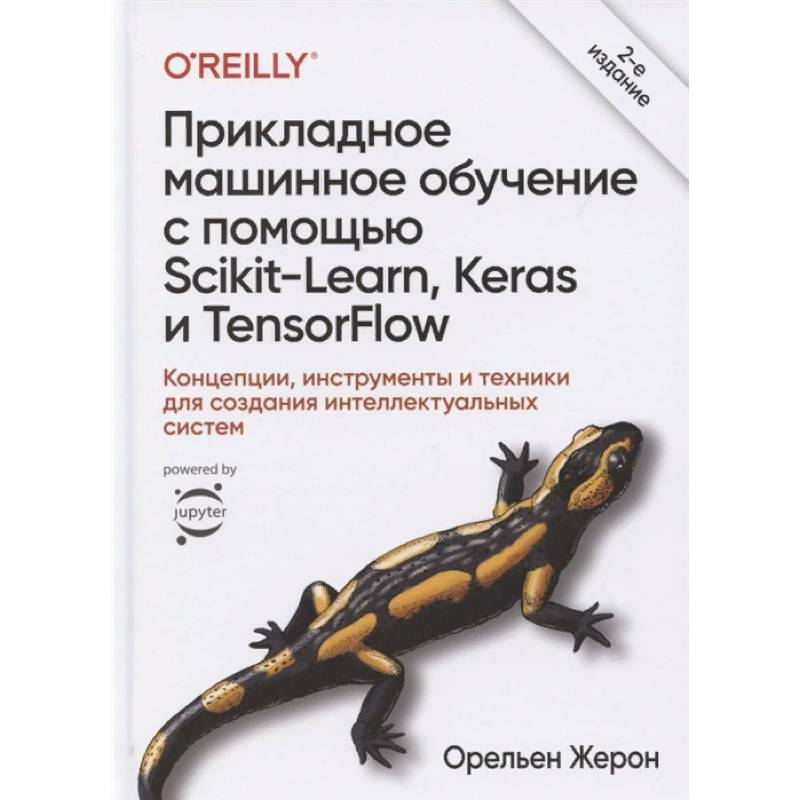Applied machine learning using Scikit-Learn, Keras and Tensorflow. Concepts, tools
Please sign in so that we can notify you about a reply
An outstanding resource for studying machine learning. You will find here clear and intuitive explanations, as well as an abundance of practical tips.
Francois Sholle, author of the Keras library, author of Deep Learning with Python
This book is a wonderful introduction to the theory and practice of solving problems using neural networks, I recommend it to everyone who is interested in mastering practical machine learning.
Pete Warden, head of the mobile development team Tensorflow
Thanks to a series of outstanding achievements, deep training significantly strengthened the entire area of machine learning. Nowadays, even programmers who know almost nothing about this technology can use simple and effective tools for implementing programs that are able to learn on data. The new edition of the Bestseller book, based on specific examples, a minimum of theory and ready-made Python Frames, will help you get an intuitive idea of concepts and tools designed to build intellectual systems.
You will master a wide range of methods that can be quickly involved in practice. Given the presence in each chapter of exercises designed to consolidate what you have learned, only experience in programming is needed to start work. All code is available on GitHub. It was updated taking into account Tensorflow 2 and the latest version of Scikit-LEARN.
Features of the book
Study the basics of machine learning on a through project using Scikit-Learn and Pandas
Build and train neural networks with numerous architectures for classification and regression using Tensorflow 2
Check out the identification of objects, semantic segmentation, mechanisms of attention, linguistic models that generate adversarial networks and many others
Explore Keras API - official high -level API interface for Tensorflow 2
Start the TensorFlow model using the Tensorflow Data API, distribution strategies, TF Transform and TF Serving
Deploy models on the AI Platform platform Google Cloud infrastructure or on mobile devices
Use teaching methods without a teacher, such as lowering dimension, clustering and detection of anomalies
Create autonomous learning agents using reinforcement training, including using the TF-Agents library
The book is discussed in a separate message on the blog of Victor Shtond.
About the author
ORELEN GELON - consultant and instructor in machine learning.
Former employee of Google, from 2013 to 2016 he led the YouTube video classification team. From 2002 to 2012, he was also the founder and head of the technical department in WiFirst (leading supplier of wireless access services in France).
2nd edition
Francois Sholle, author of the Keras library, author of Deep Learning with Python
This book is a wonderful introduction to the theory and practice of solving problems using neural networks, I recommend it to everyone who is interested in mastering practical machine learning.
Pete Warden, head of the mobile development team Tensorflow
Thanks to a series of outstanding achievements, deep training significantly strengthened the entire area of machine learning. Nowadays, even programmers who know almost nothing about this technology can use simple and effective tools for implementing programs that are able to learn on data. The new edition of the Bestseller book, based on specific examples, a minimum of theory and ready-made Python Frames, will help you get an intuitive idea of concepts and tools designed to build intellectual systems.
You will master a wide range of methods that can be quickly involved in practice. Given the presence in each chapter of exercises designed to consolidate what you have learned, only experience in programming is needed to start work. All code is available on GitHub. It was updated taking into account Tensorflow 2 and the latest version of Scikit-LEARN.
Features of the book
Study the basics of machine learning on a through project using Scikit-Learn and Pandas
Build and train neural networks with numerous architectures for classification and regression using Tensorflow 2
Check out the identification of objects, semantic segmentation, mechanisms of attention, linguistic models that generate adversarial networks and many others
Explore Keras API - official high -level API interface for Tensorflow 2
Start the TensorFlow model using the Tensorflow Data API, distribution strategies, TF Transform and TF Serving
Deploy models on the AI Platform platform Google Cloud infrastructure or on mobile devices
Use teaching methods without a teacher, such as lowering dimension, clustering and detection of anomalies
Create autonomous learning agents using reinforcement training, including using the TF-Agents library
The book is discussed in a separate message on the blog of Victor Shtond.
About the author
ORELEN GELON - consultant and instructor in machine learning.
Former employee of Google, from 2013 to 2016 he led the YouTube video classification team. From 2002 to 2012, he was also the founder and head of the technical department in WiFirst (leading supplier of wireless access services in France).
2nd edition
Author:
Author:Geron Orlya
Cover:
Cover:Hard
Category:
- Category:Computer & Technology
Publication language:
Publication Language:Russian
Paper:
Paper:Offset
ISBN:
ISBN:978-5-907203-4
No reviews found
